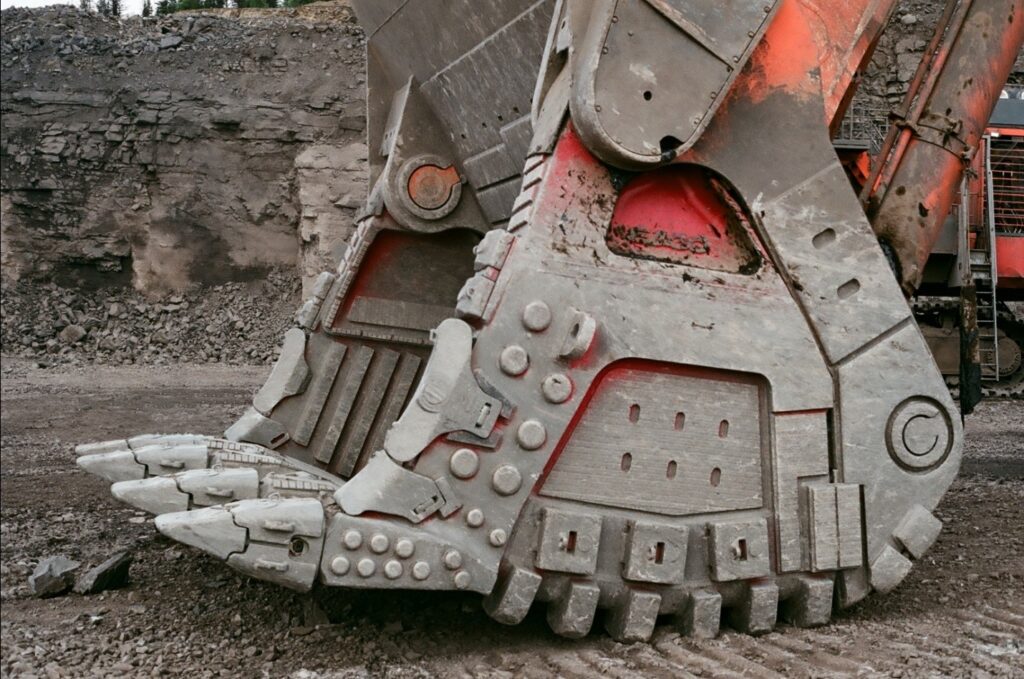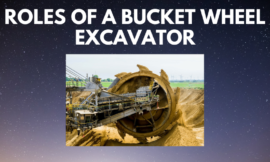Introduction to Excavator Buckets
An excavator is a construction equipment equipped with various attachments for digging purposes. Excavator buckets are one such common attachment. Read on for a guide to excavator buckets and their make.

The Material used in Excavator Buckets
We make Excavator Buckets with Solid Steel. However, some manufacturers use alloy steel with other metals to manufacture buckets.
For Example , JCB uses high quality steel such as MS or SS to manufacture excavator buckets , additionally they use Stainless Steel and Alloy.
Maan Global Industries in India manufacture low-cost excavator buckets such as digging and grading buckets. The material used for their buckets usually includes Iron, MS, Stainless Steel, and Alloy.
On the other hand, We use MS Metal and alloy steel to manufacture Telehandler bucket.
What is steel the used in Excavator Buckets?
More specifically, the Australian manufacturer, OZ Excavator Buckets makes use of Grade 400 steel (or similar hard steel) to manufacture excavator attachments.
Generally we use steel to make buckets. It makes it last longer and increases its digging ability.
A well known trade name for manufacture of digger buckets is the Rhinox-Group. This group uses Hard wearing steel to manufacture buckets.
Some of their buckets have got wear straps to increase wear resistance. They make excavator buckets of different designs and capacities.
Generally steel alloy elements such as chromium, molybdenum, columbium, and vanadium are used for making excavator parts. Other alloys are carbon, iron and nickel.
One such hard alloy is martensitic steel. It is used to manufacture excavator teeth in the mining industry.
Steel is generally used to make buckets.

Parts of an Excavator Bucket and what they are made of
The following are the parts of excavator buckets and what components are used to make them.
Pins for Excavator buckets
The components that usually makeup excavator pins are AISI 4130 or 4140 steel. These AISI 4000 series of steels comprise chromium and molybdenum. Both of them increase the overall ability to make them hardened.
However, chromium increases the resistance to corrosion while molybdenum increases strength.
For the AISI 4130, the number 4 represents the class and alloy components of steel. The number 1 indicates the percentage of the alloying elements – roughly 1% chromium and molybdenum by mass. The last two numbers 3 and 0 indicate that the carbon concentration is 0.30% carbon.
Other cheaper excavator pins may have material specifications of AISI 1045.
Generally, the bushings have the same material composition as the pins.
Excavator Bucket Sides and Cutting Edges
The steel components contribute to the product qualities of a good bucket. However, the front leading edge usually has thicker steel compared to the rest of the excavator bucket. Consequently, it has the strongest wear resistance.

The front leading edge has the strongest wear resistance
Typically, AR steel plate is used in making the bucket sides and cutting edge of an excavator bucket. The grades commonly used are AR360 and AR400.
Both grades are heat-treated so they give good abrasion resistance which will also provide high-impact strength. However, the abrasion resistance and yield strength of AR 400 are higher.
Excavator Bucket Shell
Here, ASTM A572 Grade 50 (also written as A-572-50) is the material used. It is a low alloy steel that has columbium and vanadium. Vanadium contributes to its toughness and high strength.
Similarly, it has higher strength and lower weight as compared with other alloy steel like A36. This makes it preferable. Moreover, it is ready to weld and form.
Excavator Bucket Teeth

There are two methods of manufacturing bucket teeth. They are casting and forging. In turn, the primary alloying elements are different.
Cast bucket teeth can have nickel and molybdenum as the primary steel alloy elements. Both elements contribute to the hardenability, corrosion reduction, and strength of the steel. However, Nickel can further increase the toughness.
Sometimes, we use ductile iron to make cast bucket teeth that has undergoes heat treatment for wear and impact strength.
Alternatively, forged bucket teeth have heat-treated alloy steel that varies in type with different manufacturers. Treating the alloyed steel with heat increases impact strength and improves wear properties.
Again, some bucket teeth use high manganese steel materials. One disadvantage is that it may not provide a high wear-resistant effect as ordinary carbon steel.
Still, other bucket teeth use low carbon alloy bucket teeth for mining operations. The low alloy content accounts for better wear resistance.
Types Of Excavator Buckets And What They Are Made Of
You can use an excavator to dig trenches, do landscaping, lay pipes, or even move snow. The variety of bucket types makes it possible to work with varied materials. The construction equipment manufacturer will have some or all types of excavator buckets and will have it installed upon request.
The following are the types of excavator buckets and what they are made of.
General Types of Excavator Buckets
1. What are Digging Buckets?
You can also call them general-purpose or all-purpose buckets. They are very versatile and are the default attachment that comes with an excavator. It has short, blunt teeth and comes in many sizes.
Furthermore, it is regarded as all-purpose because it can move dirt, sand, clay, gravel, loam, top soil, and other more abrasive materials.
2. What are Ditching Buckets?
Their other names are cleaning or grading buckets. They have unique smooth and flat cutting edges. Their cutting edges are also reversible while their side cutters are weld-on. The smooth edges make it appropriate for working on soft materials and soils.
Thus, the applications of a ditching bucket include landscaping, slope shaping, ditch maintenance, road construction, and utility work.
3. What are Trenching Buckets?
Like the name implies, trenching buckets are used to dig trenches. This includes narrow cable trenches, pipe culverts, and drains. Moreover, it maintains a fast cycle time while digging deep.
Trenching buckets are characterized by their sharp flat blades, extended front section, and narrow shapes.
4. What are Angle-Tilt Buckets?
These are called angle tilt buckets because they have a 45-degree rotation feature. As such, they are appropriate for creating precise slopes. In addition, they can shape more land without having to change positions too frequently.
Thus, angle tilt buckets are applied during grading, sloping, trenching, finishing, clearing land or snow and landscaping.
5. What are Heavy-Duty Buckets?
Again, you can call these severe-duty buckets. They have the general-duty, heavy-duty, severe-duty, and extreme-duty varieties. Unsurprisingly, they enhance the digging process for heavy or abrasive materials
Composition Of Heavy-Duty Excavator Buckets :
They are made from high-strength, abrasion-resistant steel.
Uses Of Heavy-Duty Excavator Buckets :
Their high durability and strength make them suitable for use in rock quarries. They work on high-density materials such as strong clay, blasted rock, stone, granite, basalt, shale, gravel, and high-silica sand.
Special-duty Types of Excavator Buckets :
You find these less commonly used buckets having special buckets for specific applications. As the following.
6. What are Skeleton Buckets?
As you can imagine, these buckets have heavy plates with gaps in between and are called riddle buckets. You can sift out coarse soil and rocks and allow fine soil to fall through.
7. What are V-bucket Excavators?
You guessed it right. These buckets can dig angular V-shaped trenches to lay pipes. They may have some tapered side plates in some designs.
This V-shape designed excavator is used to make space for utility cables.

8. What are Excavator Rock buckets?
Yes, rock buckets can break through hard rock easily. Like the digging buckets, it has long, sharp teeth and a V-shaped cutting edge. The cutting edges are reinforced with added material and sharper teeth. This gives it optimal pushing power.

9. What are Hard-pan Excavator buckets?
Similar in design to rock buckets, hard-pan buckets have ripper teeth attached to the back of the bucket. It can loosen compacted soil in the process of digging.
It was made to be durable and has great strength.
10. What are Clean-Up Buckets?
During excavation large amounts of debris or mud is normally lying around. That’s where clean-up excavator buckets come in handy. They clean up areas worked on.
They are attached to excavators and do not have any protruding teeth, Which has low maintenance costs.
11. What are Auger Buckets?
With Auger excavation buckets, many digging jobs are done together. These jobs include digging, scraping, and clearing. As such, it saves time and makes work more efficient.
12. What are Clam-Shell Excavator Buckets?
We attach the Clam-shell buckets by a hangar or bracket. It has a defining two-piece bucket that hinges at the middle to form a claw-like appendage. In addition, it has a cutting edge that digs in a vertical direction.
The cutting edge has specially designed tooth points that provide higher strength and longer life. This makes it commonly used in dredging, excavation, or material handling.
The bucket has a smooth inner surface , therefore materials of high viscosity such as mud and clay to unload easily.
The outer layer is reinforced with an added layer of wear straps for better wear resistance.
Composition Of Clam-Shell Buckets :
We make a Clam-shell bucket with high tensile steel. As such, it is wear-resistant and has a bucket capacity of 1 cubic meter upwards.
13. Grab Excavator Buckets
What are Excavator Bucket Sizes?
You have to make sure your excavator bucket size matches the specifications of your excavator. For example, what bucket size you use on a 20-ton excavator is not the same size you would use on an 8-ton excavator. It would be too big and reduce efficiency.
Excavator Bucket Size Chart :
A tool that can help you identify the right excavator bucket size is an excavator bucket size chart. Sizes range from small 750KG excavators to 19 to 25 ton massive machines.
Factors To Consider While Choosing Excavator Buckets
You have to choose an excavation bucket that matches the operating capacity of your machine.
The following are some of the factors to be considered in choosing excavator buckets.
The application of the Excavator buckets
What soil conditions are you working with? If you handle abrasive materials with heavy digging and truck-loading applications, you should opt for severe-duty buckets. They have abrasion-resistant material that aids digging in pit and quarry operations.
The Right Bucket Type
You can use specially designed bucket types for various applications. For example, if you are digging narrow deep trenches that need fast cycle times, you should use trenching buckets.
On the other hand, if you need a smooth operation in sand and clay, you can use ditching buckets. We can also use them while cleaning ditches, working on slopes, grading, back filling, and loading materials.
However, for finishing, grading and land-clearing applications, you should opt for angle tilt buckets. They are versatile and cost-effective.

Attachment Flexibility
This describes the ease of adding accessories to customize the bucket. Most importantly, you have to check the excavator’s load chart for the machine’s lifting capability.
For instance, with a power tilting coupler, you have less need for multiple attachments and manual labor. It has increased attachment flexibility that eliminates the need to change attachments while performing certain tasks. Besides, with a quick coupler, you have a quality attachment system that expands attachment versatility.
It also produces higher utilization rates. You can easily switch buckets (between ditching, trenching, or tilt bucket) in stages.
Wear Items And Replacement Parts
You have to regularly check wear items such as bucket teeth and bucket adapter for replacement. Your daily maintenance checks should include inspections of the excavator, the bucket shell, the bucket teeth, cutting edges, and heel.
This will help prolong the life of the bucket.
Benefits of High-quality Steel Excavator Buckets
Better steel always improves your excavator bucket. As all buckets are subjected to wear. As such, using harder abrasion-resistant steel rather than mild steel will certainly be beneficial. Moreover, it increases service life and reduces maintenance costs.
Improves Service Life
You can imagine how short the service life of an A36, A514, or S355 bucket would be if exposed to abrasive materials. The steel structure of such buckets is relatively mild for such work.
Increases Strength, lightness, and Capacity
We can use Hard steel to make tougher structural material to produce stronger and lighter buckets. For example, using a Hardox 450 wear-resistant steel for all the main components of a bucket helps it outlast buckets with lower-grade steel.
Moreover, the overall performance is optimal for strength, lightness, and high capacity. How? The lightness ensures the use of a higher-capacity bucket Consequently, the number of passes in loading a truck will reduce. Clearly, this will increase productivity and efficiency.
Reduces Overall Weight and Fuel Consumption
You save overall bucket weight and use a thinner material when you use a higher grade steel instead of mild steel. As a consequence, this reduces the wear and tear on the hydraulic system and excavator boom. What’s more? It reduces fuel consumption.
Another advantage is the increase the service life when you maintain the same thickness of the bucket.
Less Expensive in the Long Run
As regards costs, higher grade steel products perform better and last longer. In the long run this is less expensive. They have fewer breakdowns.
For example, you could purchase those ‘eBay special buckets’ cheaply online. The buckets come with low steel quality and are not properly heat-treated and hardened.
Therefore, they wear out quickly and need to be replaced in a short time.
Excavator Bucket’s Life
Without regard to the make of the excavator buckets , the life cycle will depend on several factors.
First, the environment matters. Do expose the bucket to extreme heat, cold, irregular surfaces, and tough environmental difficulties. You should also keep it indoors during periods of prolonged disuse.
Second, regular Maintenance is important. You should regularly conduct inspections and perform repairs.
Third, Operators should balance power and efficiency during operation. They should follow the usage prescriptions and avoid errors.

Operators should follow the usage prescriptions.
With the above factors properly considered, the life of a bucket excavator can be span between 7,000-10,000 hours.
Conclusion
No doubt, excavator buckets are highly useful as excavator attachments. They assist in a wide variety of tasks. Having a guide to excavator buckets and their make can help you use them well and get efficient results and to dig more Cubic Yds of earth.





